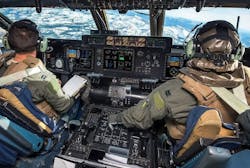Systems upgrades and technology insertion projects roll in to keep military systems on the leading edge
THE AEROSPACE & DEFENSE BLOG – I can't remember when I've seen so many projects to upgrade U.S. military systems in such a short a time as I did in June. The Pentagon awarded at least 12 contracts in June -- probably more -- which goes to show how much the U.S. Department of Defense (DOD) relies on systems upgrades and technology insertion to keep military forces on the leading edge.
Avionics computers and networking, cockpit displays, electro-optical sensors, smart munitions, missiles, submarine combat systems, software, and digital signal processing are among the highlights of upgrade projects in June that collectively were worth more than $700 million.
The orders for upgrades and technology insertion started rolling in around early June when the U.S. Air Force asked Lockheed Martin Corp. will upgrade the multifunction displays in C-5M Super Galaxy giant four-engine cargo jets in a $34.7 million order.
Next was a $23.4 million order for Lockheed Martin to upgrade for technical insertions and support for the AN/BVY-1 Integrated Submarine Imaging System (ISIS). Following that was announcement of a avionics upgrade on a Cessna Citation CJ2+ by Collins Aerospace.
Related: Top technology challenges this decade for the warfighter
Next was an announcements that Intellisense Systems Inc. in Torrance, Calif. will provide replacement multifunction controls and displays for the U.S. Air Force C-5M cargo jet. Around mid-June was a $33 million U.S. Army order to Lockheed Martin to refurbish M270 Multiple Launch Rocket System (MLRS) field artillery systems.
The upgrade projects to keep systems on the leading edge just kept coming. The Navy let a $39.7 million order to the Boeing Co. for additional Distributed Targeting Processor-Networked (DTP-N) for U.S. and Australian F/A-18E/F and EA-18G attack jets.
The Navy also asked Boeing to refurbish 25 recertified Harpoon anti-ship missiles in a $16.9 million order, and then the Navy asked General Dynamics Corp. to maintain and upgrade the AN/BYG-1 submarine combat system in a $15.9 million order.
The second half of June saw a $450 million Air Force contract to Lockheed Martin for the Joint Air-to-Surface Standoff Missile (JASSM), followed by a $22.1 million Army order to Lockheed Martin to upgrade the Target Acquisition Designation Sight/Pilot Night Vision Sensor (M-TADS/PNVS) system, also known as Arrowhead with the Modernized Day Sensor Assembly (M-DSA) kits and spare parts for Army AH-64 Apache attack helicopters.
Related: SOSA standard taking hold in military embedded computing
Months's end saw a $29.4 million Navy contract to Raytheon Technologies Corp. to upgrade AGM-154C Block III Joint Standoff Weapon (JSOW) hard-target-penetrating and data-linked medium-range precision-guided smart munitions for the governments of Taiwan, Bahrain, and Canada.
The last one I saw -- and I certainly missed some -- was a $43.8 million Navy order to Boeing to provide processors for the Distributed Targeting Processor-Network (DTP-N) system on Super Hornet and Growler aircraft.
With one or two exceptions these are not big orders; in fact they're pretty routine, except for the large number of these contracts and orders for systems upgrades and technology insertion.
Related: How military harvests technology from commercial industry
These transactions are a reminder that the Pentagon doesn't have unlimited access to money, and military leaders must do the best they can with the money they have to keep sophisticated weapons systems functioning and able to meet the best that U.S. adversaries can field.
Fortunately the military in recent years has become adept at drawing the best from commercially developed technologies, adapting them for aerospace and defense applications, and getting improved and replacement technologies into the field as quickly as they can.
Realistically today, upgrades and technology insertion projects, not big new procurement programs, are the best and only way for military leaders to keep a high-tech defense force in place for when and where it's needed.
About the Author
John Keller
Editor-in-Chief
John Keller is the Editor-in-Chief, Military & Aerospace Electronics Magazine--provides extensive coverage and analysis of enabling electronics and optoelectronic technologies in military, space and commercial aviation applications. John has been a member of the Military & Aerospace Electronics staff since 1989 and chief editor since 1995.
